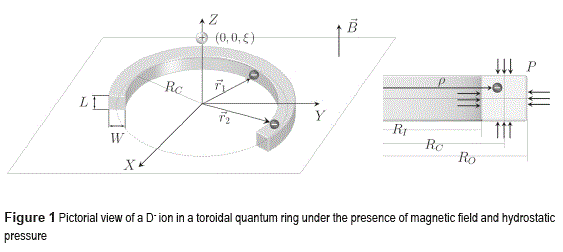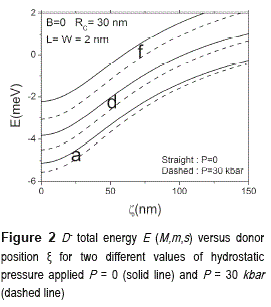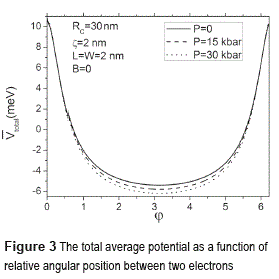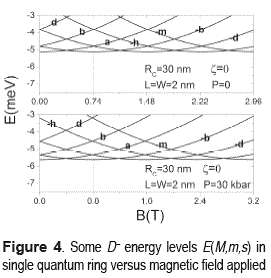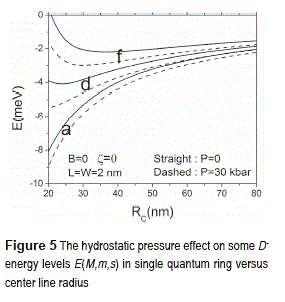Services on Demand
Journal
Article
Indicators
-
 Cited by SciELO
Cited by SciELO -
 Access statistics
Access statistics
Related links
-
 Cited by Google
Cited by Google -
 Similars in
SciELO
Similars in
SciELO -
 Similars in Google
Similars in Google
Share
Revista Facultad de Ingeniería Universidad de Antioquia
Print version ISSN 0120-6230
Rev.fac.ing.univ. Antioquia no.71 Medellín Apr./June 2014
ARTÍCULO ORIGINAL
Hydrostatic pressure and magnetic field effects on the energy structure of D- ion confined in a toroidal quantum ring
Efectos de la presión hidrostática y del campo magnético sobre la estructura de energía de un ión D- confinado en un anillo toroidal
Yoder Alberto Suaza1, Marlon Rincón Fulla1,2, Jairo Humberto Marín1*
1'Escuela de Física, Universidad Nacional de Colombia, A.A.3840. Medellín, Colombia.
22Facultad de Ingeniería, Institución Universitaria Pascual Bravo. A.A 6564. Medellín, Colombia.
3Grupo de Investigación GIDETECHMA. Facultad de Ingeniería Mecánica Universidad Pontificia Bolivariana de Bucaramanga. Km. 7 vía Piedecuesta. C.P. 50031. Bucaramanga, Colombia.
*Autor de correspondencia: teléfono:: + 57 + 4 + 4309327, correo electrónico: jhmarca65@gmail.com ((J. Marín)
(Recibido el 19 de septiembre de 2013. Aceptado el 18 de enero de 2014)
Abstract
The energy structure of a D- ion, that is two electrons bound to a fixed donor impurity, imprisoned in a toroidal quantum ring is calculated as the full system is simultaneously under the presence of hydrostatic pressure probe and threading magnetic field. With the purpose of studying the D- energy properties; we have assumed very narrow quantum rings which allow us to use the well-known adiabatic approximation in order to decouple the fast motion in radial and axial direction from the slow rotational motion. The changes of the energy level-ordering and the crossover among the curves as a function of center line radius, donor position, and magnetic field are calculated for different values of the hydrostatic pressure. Finally, we contrast the results with those previously reported for limit cases. From these comparisons it is possible to establish an excellent agreement among the different results which allow us to show the quality of the model implemented in the present work.
Keywords: Ion D-, quantum ring, energy spectrum, hydrostatic pressure, Wigner's crystal
Resumen
Se calcula la estructura de energía de un ión D-, es decir dos electrones ligados a una impureza donadora fija, encarcelada en un anillo cuántico toroidal cuando el sistema completo está simultáneamente bajo la presencia de un campo de presión hidrostática y de un campo magnético. Con el propósito de estudiar las propiedades del ión D-, nosotros asumimos que los anillos cuánticos son muy estrechos, lo cual nos permitirá usar la bien conocida aproximación adiabática para desacoplar el movimiento rápido en direcciones radial y axial del movimiento lento de rotación. Se estudian los cambios en el ordenamiento de los niveles y el cruce entre las curvas como una función de la línea central del anillo, posición de la donadora, y del campo magnético para diferentes valores de presión hidrostática. Finalmente, nosotros comparamos los resultados con aquellos previamente reportados para casos límites. A partir de estas comparaciones es posible establecer un excelente acuerdo entre los diferentes resultados, lo cual demuestra la calidad del modelo implementado en este trabajo.
Palabras clave:Ión D- anillo cuántico, espectro energético, presión hidrostática, cristal de Wigner
Introduction
The rapid progress in semiconductor growth technology has made possible to fabricate quantum dots (QDs) [1, 2] with diverse morphologies: lenses, discs, conical pyramids, camel domes, and rings, mainly. These semiconductor nanostructures are characterized by well- defined interfaces and very small height-to-base aspect ratio. Typical values for QDs height and base radius are 3 nm and 70 nm, respectively [3]. Taking into consideration the fact that de Broglie wavelength of an electron is much greater than QD's dimensions, these particles are confined in all three directions which yield a quantization of electron energy states. These electronic energy levels are strongly dependent upon both morphology and size of the QDs. In consequence, the more distinctive features have the QDs, the better it will be the possibilities to make up the electron energy spectrum. This fact can be exploited in favor of tailoring the QD carrier opto-electronic properties according to the engineering potential applications. For these reasons, the QDs in a ring-shape usually named quantum rings (QRs) [4] have attracted great deal of attention in the last few years, because its singular but non trivial topology related to the central crater offer us diverse possibilities to study different quantum effects impossible to achieve in other nanostructures. For example, the QRs allow us the observation of persistent currents as well as the Aharanov-Bohm and quantum Hall effects [5, 6].
In the last few years, A. Lorke and co-workers [3] by using self-assembled crystal growth method have reported the fabrication of in- plane InGaAs QRs spatially separated. This finding has motivated numerous theoretical and experimental works which have been undertaken in order to obtain the electron energy structure as a function of the QRs geometrical parameters and the external fields. Different types of calculation methods [7-9] have been implemented for this purpose, for instance perturbation theory, variational method, exact matrix diagonalization, and finite elements. These methods have shown be mathematically and computationally a bit cumbersome and quite heavy.
Despite the donor or acceptor impurities in semiconductor nanostructures can largely affect the carrier electro-optical and kinetic properties. to the best of our knowledge, works that calculate the energy spectrum of neutral and ionized donor impurities in toroidal QRs under external probes such as hydrostatic pressure and magnetic field are really scarce or not addressed in detail in literature. It is due the energy structure calculations become really hard because the greater is the number of particles into the QRs and the external fields applied on this nanostructure the heavier are the calculations. In consequence, the simplest few-particle system that can be studied under conditions of strong confinement and extemal probes is the negative ionized donor (D-) [10-15]. This ionized impurity has an analogue in atomic physics which is the negative hydrogen ion H- [16]. The ion D- both in semiconductor bulk crystal as an isolated system is characterized by having only one bound state which corresponds to spin-singlet configuration. Nevertheless, D- ion in semiconductor nanostructures can present a novel electronic structure with different bound excited states as a consequence of the electron strong confinement. This fact could be used to innovative opto-electronic devices with novel properties. For this reason in the last few years, there is an increasing interest in this system. Taking into account that D- is compound by two electrons bound to one positive charged center, we can use this system as a starting point to analyze the role played by the electron-electron correlation effects in many particle problems. In spite of several studies on ion confined in quantum dots [10-13] and quantum wells [14-15] have been reported in the last few years, experimental and theoretical researches over D ions energy structure in quantum rings under the presence of external probes are really scarce. The above mentioned physical facts, as well as many others, have motivated us to analyze the D- under strong confinement conditions. In this regard, we propose a simple model in which the two electrons are imprisoned in a toroidal quantum ring while the positive charged center is fixed in any point on symmetry axis perpendicular to the quantum ring plane. The full system is under the influence of the external probes: hydrostatic pressure and threading homogeneous magnetic field. In figure 1 we present a pictorial image of the system studied in the present work. The left image in figure 1 represents the three dimensional toroidal quantum ring. The QR considered is engendered by revolving around the z-axis a rectangle of height L and width W. The QR's rectangular cross-section and the z axis are taken to lie on the same plane. The QR is limited by two cylindrical surfaces with inner radius RI, and outer radius RO, respectively. The positive charged center is located at the point  while
while  and
and  represent the electron vector positions. The right image in Figure 1 corresponds to QR rectangular cross-section which has been drawn in order to define the most representative geometrical parameters of QR: inner radius (RI), outer radius (RO), and center line radius (Rc=(RO+RI)/2). p denotes the electron cylindrical coordinate while the vertical and horizontal arrows are used in order to represent the existence of the external probe corresponding to the hydrostatic pressure.
represent the electron vector positions. The right image in Figure 1 corresponds to QR rectangular cross-section which has been drawn in order to define the most representative geometrical parameters of QR: inner radius (RI), outer radius (RO), and center line radius (Rc=(RO+RI)/2). p denotes the electron cylindrical coordinate while the vertical and horizontal arrows are used in order to represent the existence of the external probe corresponding to the hydrostatic pressure.
Theoretical framework
In the effective-mass approximation, the D- center Hamiltonian under the effects of hydrostatic pressure, P and z-direction magnetic field  , can be written in cylindrical coordinates (ρ, φ, z) as described in Eq. (1a):
, can be written in cylindrical coordinates (ρ, φ, z) as described in Eq. (1a):

Where the one-particle Hamiltonian and the electron-electron distance are defined in Eq. (1b) and Eq. (1c), respectively
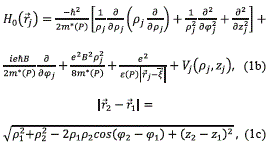
where Vj(ρj, zj) is the j-electron confinement potential, equal to zero and infinite inside and outside the QR, respectively. The coordinate's origin system has been located at the symmetry center of the QR.
The effect of the applied hydrostatic pressure on the QR geometrical parameters have been considering in Eq. (2) and Eq. (3) through the following analytic functions [17] for height L(P) and center line radius Rc(P):

being L(0) and RI,O,C(0) the QR height and inner, outer, center line QR radii without pressure applied, respectively. S11 and S12 are the GaAs compliance constants.
The hydrostatic effects on the electron effective mass and dielectric permittivity are given by the Eq. (4) and Eq. (5), respectively


where m0 is the free electron mass and Eg (P) is the pressure dependent GaAs band gap in meV. which is given by Eq. (6):

In this work, kbar units are used in order to measure the hydrostatic pressure effects.
The corresponding Schrodinger equation for Hamiltonian (1) cannot be solved exactly because the presence of repulsive electron-electron and the attractive donor-electron Coulomb interactions. In consequence, an approximated method should be implemented. On this subject, for the sake of mathematical convenience and taking in mind the realistic QR dimensions characterized by center line radii much greater than the height, in this work, very narrow nano- rings are considered in order to use the well- known adiabatic approximation (AA) [11]. This approximation allows us to decouple the electron rapid motion in z and radial directions from its slow rotational one. By following the same procedure described in reference [11], we can reduce the 3-Dimensional Schrodinger equation into the following 1-Dimensional:
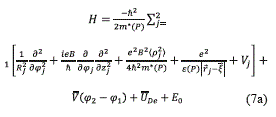
being V(φ2, φ1) the electron-electron average potential interaction which is expressed as:

 the total donor-electron average potential for both electrons, which is a constant given by:
the total donor-electron average potential for both electrons, which is a constant given by:
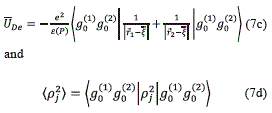
where go(j)= go(j)(ρj, zj) and E0 are the exact wave function and the corresponding eigen-energies in an infinite rectangular two-dimensional quantum well corresponding to the electron motion along the cross-section. The eigen-values E of the two- particle one-dimensional Schrodinger equation with Hamiltonian (7) can be solved by using the center-of-mass  and relative coordinates φ=φ2-φ1, which allows us to re-write the Hamiltonian (7) as H=Hc+Hr being Hc and Hr the center-of-mass and relative terms, respectively. The exact eigen-values for center-of-mass term are
and relative coordinates φ=φ2-φ1, which allows us to re-write the Hamiltonian (7) as H=Hc+Hr being Hc and Hr the center-of-mass and relative terms, respectively. The exact eigen-values for center-of-mass term are  where M=0,±1,±2,... while the eingen-values of the operator Hr denoted by Er (m,s) should be obtained numerically by solving the following one-dimensional Schrodinger equation:
where M=0,±1,±2,... while the eingen-values of the operator Hr denoted by Er (m,s) should be obtained numerically by solving the following one-dimensional Schrodinger equation:

being m=0,±1,±2. The quantum numbers M and m define the center-of-mass and the two-electron relative angular momentum, respectively, while s = 0 denotes even solutions or singlet states while s = 1 denotes the odd solutions.
Results and discussion
The evolution of D- total energy E(M,m,s) as a function of the donor position for two different values of hydrostatic pressure applied P=0 (solid line) and P=30 kbar (dashed line) is displayed in Figure 2. The results were obtained by considering quantum rings with with L=W=2 nm and center line radius Rc=30 nm. Three different states were plotted, a [(E (0,0,0)], d [(E(±2,0,0)],and f [(E(±2,2,1)]. The notation used in this work is according with those previously reported in reference [18]. From these curves are possible to observe for small values of  that the electron- donor-electron interaction is really predominant. Nevertheless, as the on axis donor begins to move away from the quantum ring center along the z axis and independently of the hydrostatic pressure value, the total energy begins to increase. It is due to the electron-electron correlation begins to play a protagonist role while the attractive Coulomb interaction between electrons and donor tend to decrease. For small values of donor position the slopes of the curves are really noticeable but this behavior tends to disappear for
that the electron- donor-electron interaction is really predominant. Nevertheless, as the on axis donor begins to move away from the quantum ring center along the z axis and independently of the hydrostatic pressure value, the total energy begins to increase. It is due to the electron-electron correlation begins to play a protagonist role while the attractive Coulomb interaction between electrons and donor tend to decrease. For small values of donor position the slopes of the curves are really noticeable but this behavior tends to disappear for  -values greater than one effective Bohr radius. The three curves for zero pressure applied are in excellent agree with those results previously reported in Ref. [11] which shows the efficiency of the model used in this work to analyze the effects of the hydrostatic pressure and magnetic field on the D- energy spectrum.
-values greater than one effective Bohr radius. The three curves for zero pressure applied are in excellent agree with those results previously reported in Ref. [11] which shows the efficiency of the model used in this work to analyze the effects of the hydrostatic pressure and magnetic field on the D- energy spectrum.
In order to understand the hydrostatic pressure effect on D- total energy confined in a toroidal quantum ring is necessary to take into account that the increasing of hydrostatic pressure applied on the QR tends to reduce the overall size of this nanostructure. Therefore, the electron-donor- electron attractive interaction tends to increase which produces a shift down of D- total energy in comparison with the same curves for zero applied hydrostatic pressure. The D- excited states seem to feel much more the hydrostatic pressure effect because the separation between the curves for non-zero and zero hydrostatic pressure applied become much greater than the corresponding curves for ground state. In short, the hydrostatic pressure yields a differential increasing of the D- total according to each D- energy level. In order to include another reason by which the hydrostatic pressure applied on the quantum ring tends to shift down the total energy, we have also plotted the total average potential interaction  . This potential is shown in Figure 3
. This potential is shown in Figure 3
From this curve, we can appreciate that the confinement effective potential felt by electrons in its rotational motion around the z axis present a minimum value in such a way that, the greater is the hydrostatic pressure applied on the toroidal quantum ring, the deeper is the minimum of  . In consequence, when the hydrostatic pressure applied over the QR is increased the D- energy levels become deeper. This fact is really important because it could be possible to modify in real time the D- energy spectrum by changing only the strength of hydrostatic pressure applied. An increasing in the hydrostatic pressure applied on QR ensures greater stability of D- against the thermal dissociation because the energy levels are really deeper in the effective potential well described by the figure 3.
. In consequence, when the hydrostatic pressure applied over the QR is increased the D- energy levels become deeper. This fact is really important because it could be possible to modify in real time the D- energy spectrum by changing only the strength of hydrostatic pressure applied. An increasing in the hydrostatic pressure applied on QR ensures greater stability of D- against the thermal dissociation because the energy levels are really deeper in the effective potential well described by the figure 3.
D- total energy E(M,m,s) versus magnetic field strength is shown in fig. 4 for quantum rings with height W=L=2 nm and Rc= 30 nm for two different values of hydrostatic pressure applied, zero (upper panel) and 30 kbar (lower panel), respectively.
In order to understand the behavior of the curves presented in figure 4, it is necessary to say that they are result of the strong competition between the paramagnetic term (~ B) and diamagnetic one (~ B2). The curves with positive center mass angular momentum (M>=0) present a positive slope for all range of values of the magnetic field strength applied to the QR. Nevertheless, those curves with negative center mass angular momentum (M<0) present a negative slope only for very small values of the magnetic field where the paramagnetic term predominates over the diamagnetic one. However, there is a minimum point where each energy level changes this behavior being the slope positive due to the primacy of the diamagnetic term over the paramagnetic one. In consequence, the D- energy spectrum presents a B-periodic pattern named Aharanov-Bohm oscillations. This particular behavior can only be observed in quantum dots in ring-shape under threading magnetic field due to the existence of a central hole which plays a decisive role in the purpose to fabricate novel opto-eletronic devices.
We can observe from these curves that the hydrostatic pressure applied shift down the energy levels. For instance the difference between the D- ground state at zero and 30 kbar of pressure applied is almost equal to 8 % being this value is really important in order to preserve the D stability and favoring its observation at room temperature. The hydrostatic pressure effect on the D- energy spectrum can be observed by comparing the Aharanov- Bohm oscillation period at zero and 30 kbar. At zero hydrostatic pressure applied the period is approximately equal to 0.74 T while at 30 kbar is the order of 0.8 T being the difference between these values once again approximately equal to 8%. In this case, the difference is a direct consequence of the overall reduction experienced by the quantum ring under the influence of a hydrostatic pressure probe since this field reduces the center line radius of the quantum ring and the Aharanov-Bohm oscillation period is inversely proportional to the square of this center line radius.
Finally in figure 5, is shown the hydrostatic pressure effect on some D- energy levels. A shifting down of the D- energy as a non-zero hydrostatic pressure field is applied on the system was expected since the electron-donor-electron attractive interaction increases as a consequence of the overall system size reduction (see figures 2 and 3). Furthermore, figure 5 shows a noticeable effect on excited energy states for small radii due to the great electron-electron approaching. By increasing the radius systematically, these energies are reduced exhibiting a minimal. From this point the energy values tend to present a quasi linear behavior which could be intended as a turning point where the electron-electron interaction begins to overweigh the two-electron kinetic energy giving rise to a monotonic crystallization process in which the two-particle system is strongly correlated similar to the so- called Wigner crystal.
Conclusions
By using a simple model based on the adiabatic approximation is possible to calculate the D- the energy spectrum in narrow nano-rings under external probes: hydrostatic pressure and magnetic field. We show that D- energy spectrum is very sensitive to the quantum ring geometrical parameters, donor position, and external probes. The hydrostatic pressure applied yields a shifting down of D- energy levels while the magnetic field is responsible to the existence of the Aharanov- Bohm oscillations whose period is slightly dependent on the hydrostatic pressure applied.
Acknowledgments
M. R. Fulla thanks to Institución Universitaria Pascual Bravo for the time in his working day to realize this research. J. H. Marín thanks to Universidad Nacional de Colombia for the economical aids to attend the OECS 2013.
References
1. J. Stang, V. Holy, G. Bauer. ''Structural Properties of Self-Organized Semiconductor Nanostructures''. Review Modern Physics. Vol. 76. 2004. pp. 725-783. [ Links ]
2. L. Jacak, P. Hawrylak, A. Wójs. Quantum Dots. 1st ed. Ed. Springer. Germany, Berlin. 1997. pp. 5-12. [ Links ]
3. A. Lorke, R. Luyken, A. Govorov, J. Kotthaus, J. Garcia, P. Petroff. ''Spectroscopy of Nanoscopic Semiconductor Rings''. Physical Review Letters. Vol. 84. 2000. pp. 2223-2227 [ Links ]
4. Y Aharonov, D. Bohm. ''Significance of Electromagnetic Potentials in the Quantum Theory''. Physical Review. Vol.115. 1959. pp. 485-491. [ Links ]
5. T. Mano, T. Kuroda, S. Sanguinetti, T. Ochiai, T. Tateno, J. Kim, T. Noda, M. Kawabe, K. Sakoda, G. Kido, N. Koguchi. ''Self-Assembly of Concentric Quantum Double Rings'' Nano Letters. Vol. 5. 2005. pp. 425-428. [ Links ]
6. G. Timp, A. Chang, J. Cunningham, T. Chang, P. Mankiewich, R. Behringer, R. Howard. ''Observation of the Aharonov-Bohm Effect for ωcτ>1''. Physical Review Letters. Vol. 58. 1987. pp. 2814-2817. [ Links ]
7. N. Kleemans, I. Bominaar, V. Fomin, V. Gladilin, D. Granados, A. Taboada, J. García, P. Offermans, U. Zeitler, P. Christianen, J. Maan, J. Devreese, P Koenraad. ''Oscillatory Persistent Currents in Self- Assembled Quantum Rings''. Physical Review Letters. Vol. 99. 2007. pp. 146808-146811. [ Links ]
8. J. Planelles, J. Climente, F. Rajadell. ''Quantum rings in tilted magnetic fields''. PhysicaE. Vol. 33. 2006. pp. 370-375. [ Links ]
9. X. Wen. ''A Two-Electron Quantum Ring Under Magnetic Fields''. Communications in Theoretical Physics. Vol. 49. 2008. pp. 1619-1623. [ Links ]
10. F. García, J. Marín, H. Paredes, I. Mikhailov. ''Low- lying states of two-electron quasi-one-dimensional ring''. Physics Status Solidi (c). Vol. 2. 2005. pp. 3630-3633 [ Links ]
11. W. Xie. ''Negative-donor centers and absorption spectra of quantum dots''. Journal of Physics: CondensedMatter Vol. 20. 2008. pp. 365213-365217 [ Links ]
12. F. Betancur, W. Gutiérrez, J. Piña. ''Energy spectrum of on-axis negatively charged donor in toroidal-shaped ring''. PhysicaB. Vol. 396.2007. pp. 12-15. [ Links ]
13. I. Mikhailov, F. Betancur, R. Escorcia, J. Sierra. ''Off-Center Neutral and Negatively Charged Donor Impurities in Semiconductor Heterostruc tures: Fractal Dimension Method, Off-Center Neutral and Negatively Charged Donor Impurities in Semiconductor Heterostructures: Fractal Dimension Method''. Physics Status Solidi (b). Vol. 234. 2002. pp. 590-610. [ Links ]
14. L. García, J. Marín, I. Mikhailov. ''Negatively Charged Donors in Flat Quantum Dots''. Brazilian Journal Of Physics. Vol. 36B. 2006. pp. 878-881. [ Links ]
15. S. Huant, S. Najda, B. Etienne. 'Two-dimensional D- centers''. Physical Review Letters. Vol. 65. 1990. pp. 1486-1489. [ Links ]
16. F. Betancur, I. Mikhailov, J. Marín, L. Oliveira. ''Electronic Structure of Donor-Impurity Complexes in Quantum Wells'' Journal of Physics: Condensed Matter. Vol. 10. 1998. pp. 7283-7293 [ Links ]
17. E. Reyes, N. Raigoza, L. Oliveira. ''Effects of Hydrostatic Pressure and Aluminum Concentration on the Conduction-electron g Factor in GaAs-(Ga,Al) As Quantum Wells Under in-Plane magnetic fields''. Physics Review B. Vol. 77. 2008. pp. 115308-115313. [ Links ]
18. J. Zhu, Z. Dai, X. Hu. ''Two Electrons in One- Dimensional Nanorings: Exact Solutions and interaction energies''. Physical Review B. Vol. 68. 2003. pp. 045324-045331. [ Links ]













